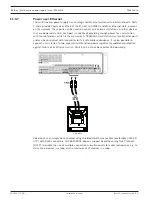
110
en | Multifunction power supply, large | PRA-MPS3
PRAESENSA
2019.11 | V1.00 |
Installation manual
Bosch Security Systems B.V.
correct charging threshold voltages to fully charge the battery without overcharging. When the
temperature sensor is not mounted correctly, the battery lifetime may be considerably
reduced. When the sensor is not connected, the battery charger will be switched off. Only use
the temperature sensor assembly that is delivered with the device.
Notice!
For compliancy to EN 54-4 and ISO 7240-4, the battery shall
-
be rechargeable;
-
be suitable to be maintained in a fully charged state;
-
be constructed for stationary use;
-
be marked with the type designation and date of manufacture;
-
be of the sealed type;
-
be mounted in in accordance with the manufacturer’s data.
A properly marked and mounted VRLA (Valve Regulated Lead Acid) battery of 12
V fulfils
these requirements. SLA (Sealed Lead Acid) and VRLA are different acronyms for the same
battery. This battery type is maintenance-free, leak-proof and position insensitive. Batteries of
this kind have a safety vent to release gas in case of excessive internal pressure build up.
AGM (Absorbed Glass Mat) refers to a specific type of SLA or VRLA and can be used also.
!
Caution!
1.
The battery must be electrically floating. Never connect any battery terminal to ground.
The battery terminals must be wired individually to the battery connection terminals of the
PRA-MPS3.
2.
A battery may not be connected to more than one PRA-MPS3, this means that it cannot be
shared by multiple power supplies.
3.
Risk of explosion if an incorrect type of battery is used.
Notice!
1.
To prevent damage to the battery always check the depth of the threaded insert of the
terminals before tightening the bolts. If needed, use shorter bolts.
2.
Make sure that all connections are tightened with the correct torque. Not only to prevent
damage, but also to keep the contact resistances as low as possible. It is good practice to
keep the red and black battery cables together and aligned for most of their length, using
cable ties or heat shrink sleeves. This reduces cable inductance and improves the accuracy of
the battery impedance measurement because the battery impedance is measured using an AC
current. The inductance of the cables is very low and may seem insignificant, but the
impedance of the battery and the resistance of the cables, cable connections and the fuse are
also very low and all these elements are in series and measured together.
3.
It is not allowed to connect any external load to the battery directly, as this will disturb the
charging process.
Battery and charging stages
The charger of the multifunction power supply is a 3‑stage charger. This is a processor-
controlled charger that offers maximum safety and ease of use, while preserving best
performance and battery lifetime. Recharging a battery is a three stage process:
–
Stage 1 (bulk charge)
: In this stage the battery is charged with a constant current, the
nominal charging current of 8.5
A. The applied voltage increases over time to keep this
current flowing while the battery charges. The actual voltage also depends on the internal
resistance of the battery and the connection cable resistance. This stage will recharge
batteries that are severely drained. There is no risk of overcharging in this stage because
Summary of Contents for PRAESENSA
Page 1: ...PRAESENSA Public Address and Voice Alarm System en Installation manual ...
Page 2: ......
Page 193: ......















































